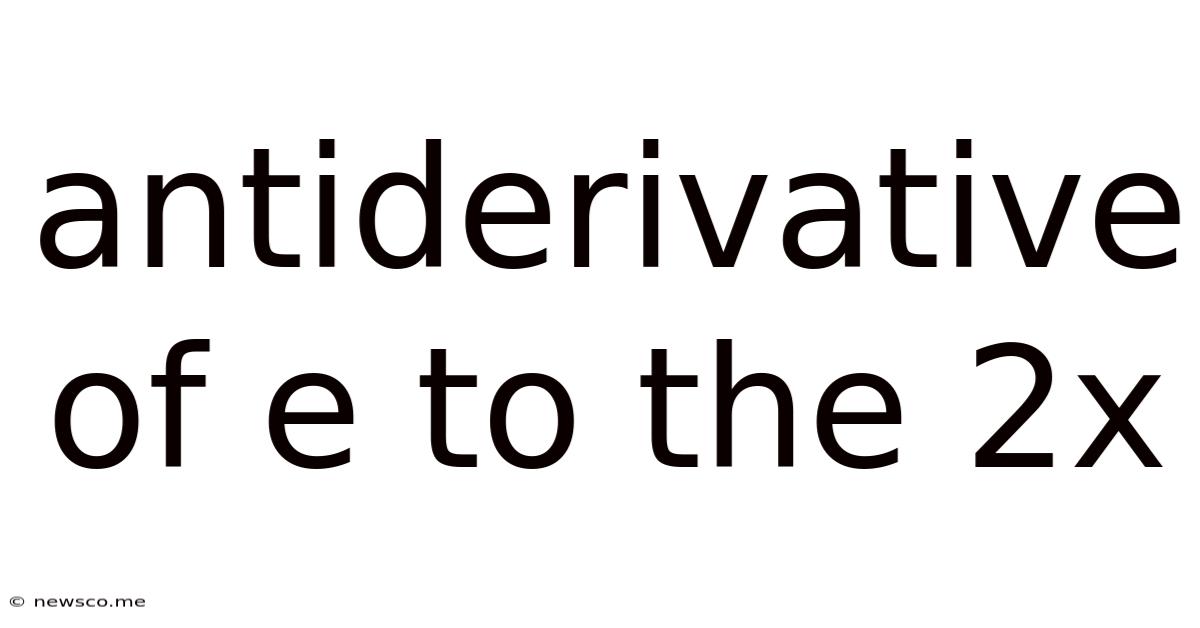Antiderivative Of E To The 2x
News Co
Mar 30, 2025 · 5 min read

Table of Contents
The Antiderivative of e^(2x): A Comprehensive Guide
The exponential function, specifically e^(2x), plays a crucial role in various fields like calculus, physics, and engineering. Understanding its antiderivative is essential for solving differential equations, calculating areas under curves, and more. This comprehensive guide delves into the intricacies of finding the antiderivative of e^(2x), exploring different approaches and providing detailed explanations. We'll move beyond a simple answer and unpack the underlying concepts to ensure a solid understanding.
Understanding Antiderivatives
Before diving into the specifics of e^(2x), let's solidify our understanding of antiderivatives. An antiderivative, also known as an indefinite integral, is a function whose derivative is the original function. In simpler terms, it's the reverse process of differentiation. If F'(x) = f(x), then F(x) is an antiderivative of f(x).
It's crucial to remember that antiderivatives are not unique. If F(x) is an antiderivative of f(x), then F(x) + C, where C is an arbitrary constant, is also an antiderivative. This is because the derivative of a constant is always zero. This constant of integration, C, is a vital component of the antiderivative and reflects the family of functions that share the same derivative.
Finding the Antiderivative of e^(2x) using the Power Rule (with a Twist)
The standard power rule for integration states: ∫xⁿ dx = (xⁿ⁺¹)/(n+1) + C, where n ≠ -1. However, e^(2x) isn't directly in this form. We need a clever application of substitution or the chain rule in reverse.
Let's consider the chain rule for differentiation: d/dx [f(g(x))] = f'(g(x)) * g'(x). If we reverse this, we get a hint about how to approach the integral.
The key is to recognize that e^(2x) is a composite function. Let's perform a substitution:
Let u = 2x. Then du/dx = 2, which means du = 2dx. We can rewrite dx as (1/2)du.
Now, we can rewrite the integral:
∫e^(2x) dx = ∫e^u * (1/2)du
This integral is much simpler:
(1/2)∫e^u du = (1/2)e^u + C
Now, substitute back for u:
(1/2)e^(2x) + C
Therefore, the antiderivative of e^(2x) is (1/2)e^(2x) + C.
Verification through Differentiation
To verify our result, let's differentiate (1/2)e^(2x) + C:
d/dx [(1/2)e^(2x) + C] = (1/2) * d/dx [e^(2x)] + d/dx [C]
Using the chain rule again:
(1/2) * e^(2x) * d/dx [2x] + 0 = (1/2) * e^(2x) * 2 = e^(2x)
This confirms that our antiderivative is correct. The derivative of our antiderivative is indeed e^(2x).
Applications of the Antiderivative of e^(2x)
The antiderivative of e^(2x) finds its application across numerous mathematical and scientific disciplines:
1. Solving Differential Equations
Differential equations describe the relationship between a function and its derivatives. Many differential equations involve exponential functions. The antiderivative of e^(2x) is crucial in finding the general solution to such equations. For instance, in solving a simple first-order linear differential equation like dy/dx = 2y, the solution involves this antiderivative.
2. Calculating Areas and Volumes
In calculus, integration is used to find the area under a curve. The definite integral of e^(2x) between two limits gives the area bounded by the curve, the x-axis, and the two vertical lines representing the limits. Similarly, in three-dimensional calculus, this antiderivative aids in calculating volumes of solids of revolution.
3. Physics and Engineering
Exponential functions, and thus their antiderivatives, frequently model processes like radioactive decay, population growth, and the behavior of circuits in electrical engineering. The antiderivative of e^(2x) is used extensively in solving problems relating to these phenomena, enabling accurate prediction and modeling.
4. Probability and Statistics
Exponential distributions, which are used extensively in probability and statistics to model the time until an event occurs, use the exponential function as their probability density function. Calculating probabilities and expectations associated with exponential distributions directly involves integration, and the antiderivative of e^(2x) (or similar functions) becomes crucial.
Further Exploration: Integration Techniques and Extensions
While substitution is a straightforward approach, other integration techniques can handle more complex variations involving e^(2x).
1. Integration by Parts
If e^(2x) is part of a product, integration by parts (∫u dv = uv - ∫v du) might be necessary. This technique effectively rewrites the integral into a more manageable form.
2. Partial Fractions
When dealing with rational functions involving e^(2x) in the denominator, partial fraction decomposition might simplify the integral, making it solvable using known techniques.
3. Dealing with More Complex Exponents
The techniques outlined can be extended to functions of the form e^(ax+b), where 'a' and 'b' are constants. A simple substitution will transform this into a form directly solvable using the method above.
Conclusion: Mastering the Antiderivative
The seemingly simple antiderivative of e^(2x) – (1/2)e^(2x) + C – opens doors to a wide range of mathematical and scientific applications. Understanding its derivation and the underlying integration principles is fundamental for anyone working with calculus, differential equations, or related fields. This deep dive into the subject has demonstrated not only the 'how' but also the 'why,' empowering you to approach similar problems with confidence and a strong theoretical foundation. Remember to always check your work by differentiating your answer to ensure it returns the original function. This crucial step verifies your solution and solidifies your understanding of the process. The more you practice, the more comfortable and proficient you will become.
Latest Posts
Related Post
Thank you for visiting our website which covers about Antiderivative Of E To The 2x . We hope the information provided has been useful to you. Feel free to contact us if you have any questions or need further assistance. See you next time and don't miss to bookmark.